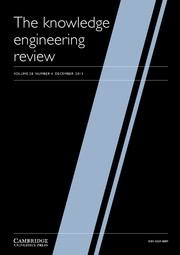Crossref Citations
This article has been cited by the following publications. This list is generated based on data provided by
Crossref.
Lefkovits, Szidónia
and
Lefkovits, László
2016.
Comparison of Boosted Gabor Feature based Local Descriptor.
Procedia Technology,
Vol. 22,
Issue. ,
p.
913.
Janoušek, Jan
Gajdoš, Petr
Dohnálek, Pavel
and
Radecký, Michal
2016.
Intelligent Information and Database Systems.
Vol. 9622,
Issue. ,
p.
169.
2017.
Big Data and Differential Privacy.
p.
59.
Chen, Zhi
Lin, Tao
Chen, Rui
Xie, Yingtao
and
Xu, Hongyan
2017.
Creating diversity in ensembles using synthetic neighborhoods of training samples.
Applied Intelligence,
Vol. 47,
Issue. 2,
p.
570.
Aridas, Christos K.
Alexandropoulos, Stamatios-Aggelos N.
Kotsiantis, Sotiris B.
and
Vrahatis, Michael N.
2017.
Engineering Applications of Neural Networks.
Vol. 744,
Issue. ,
p.
111.
Lopez-Garcia, Pedro
Masegosa, Antonio D.
Onieva, Enrique
and
Osaba, Eneko
2018.
Bioinspired Optimization Methods and Their Applications.
Vol. 10835,
Issue. ,
p.
185.
Neerbek, Jan
Dolog, Peter
and
Assent, Ira
2019.
Advances in Knowledge Discovery and Data Mining.
Vol. 11441,
Issue. ,
p.
40.
Dijkstra, Henk A.
Petersik, Paul
Hernández-García, Emilio
and
López, Cristóbal
2019.
The Application of Machine Learning Techniques to Improve El Niño Prediction Skill.
Frontiers in Physics,
Vol. 7,
Issue. ,
Xavier-Júnior, João C.
Freitas, Alex A.
Ludermir, Teresa B.
Feitosa-Neto, Antonino
and
Barreto, Cephas A.S.
2020.
An evolutionary algorithm for automated machine learning focusing on classifier ensembles: An improved algorithm and extended results.
Theoretical Computer Science,
Vol. 805,
Issue. ,
p.
1.
Livieris, Ioannis E.
Pintelas, Emmanuel
Stavroyiannis, Stavros
and
Pintelas, Panagiotis
2020.
Ensemble Deep Learning Models for Forecasting Cryptocurrency Time-Series.
Algorithms,
Vol. 13,
Issue. 5,
p.
121.
Liang, Weizhang
Sari, Asli
Zhao, Guoyan
McKinnon, Stephen D.
and
Wu, Hao
2020.
Short-term rockburst risk prediction using ensemble learning methods.
Natural Hazards,
Vol. 104,
Issue. 2,
p.
1923.
Yedla, Anurag
Kakhki, Fatemeh Davoudi
and
Jannesari, Ali
2020.
Predictive Modeling for Occupational Safety Outcomes and Days Away from Work Analysis in Mining Operations.
International Journal of Environmental Research and Public Health,
Vol. 17,
Issue. 19,
p.
7054.
Nwaila, Glen T.
Zhang, Steven E.
Frimmel, Hartwig E.
Manzi, Musa S. D.
Dohm, Christina
Durrheim, Raymond J.
Burnett, Mark
and
Tolmay, Leon
2020.
Local and Target Exploration of Conglomerate-Hosted Gold Deposits Using Machine Learning Algorithms: A Case Study of the Witwatersrand Gold Ores, South Africa.
Natural Resources Research,
Vol. 29,
Issue. 1,
p.
135.
TUĞ KAROĞLU, Tuğba
and
OKUT, Hayrettin
2020.
Classification of the placement success in the undergraduate placement examination according to decision trees with bagging and boosting methods.
Cumhuriyet Science Journal,
Vol. 41,
Issue. 1,
p.
93.
Malsa, Nitima
Vyas, Vaibhav
and
Gautam, Jyoti
2021.
RMSE calculation of LSTM models for predicting prices of different cryptocurrencies.
International Journal of System Assurance Engineering and Management,
Aderka, Idan M.
Kauffmann, Amitay
Shalom, Jonathan G.
Beard, Courtney
and
Björgvinsson, Thröstur
2021.
Using machine-learning to predict sudden gains in treatment for major depressive disorder.
Behaviour Research and Therapy,
Vol. 144,
Issue. ,
p.
103929.
Calamaro, Netzah
Beck, Yuval
Ben Melech, Ran
and
Shmilovitz, Doron
2021.
An Energy-Fraud Detection-System Capable of Distinguishing Frauds from Other Energy Flow Anomalies in an Urban Environment.
Sustainability,
Vol. 13,
Issue. 19,
p.
10696.
Zhang, Steven E.
Nwaila, Glen T.
Bourdeau, Julie E.
and
Ashwal, Lewis D.
2021.
Machine learning-based prediction of trace element concentrations using data from the Karoo large igneous province and its application in prospectivity mapping.
Artificial Intelligence in Geosciences,
Vol. 2,
Issue. ,
p.
60.
Harine Rajashree, R.
and
Hariharan, M.
2021.
Machine Learning, Deep Learning and Computational Intelligence for Wireless Communication.
Vol. 749,
Issue. ,
p.
127.
Kashef, Rasha
2021.
A boosted SVM classifier trained by incremental learning and decremental unlearning approach.
Expert Systems with Applications,
Vol. 167,
Issue. ,
p.
114154.


